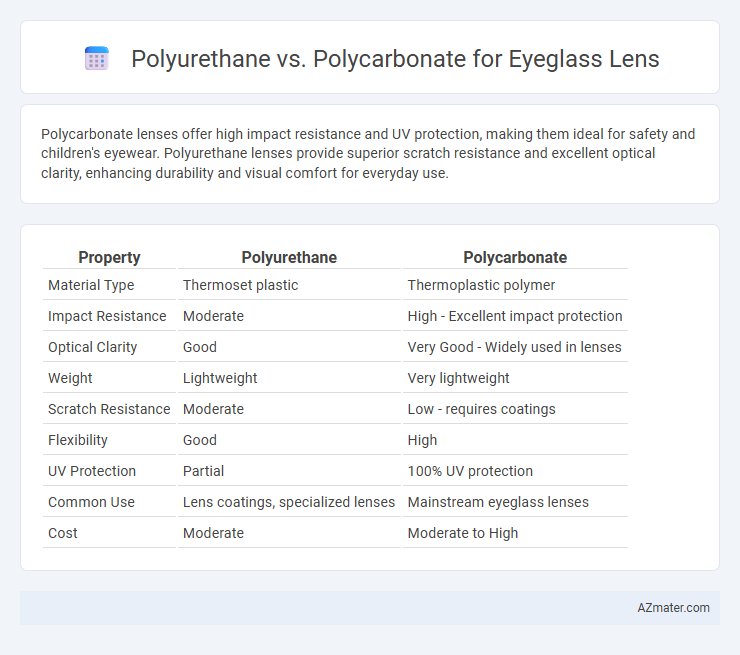Polycarbonate lenses offer high impact resistance and UV protection, making them ideal for safety and children's eyewear. Polyurethane lenses provide superior scratch resistance and excellent optical clarity, enhancing durability and visual comfort for everyday use.
Table of Comparison
| Property | Polyurethane | Polycarbonate |
|---|---|---|
| Material Type | Thermoset plastic | Thermoplastic polymer |
| Impact Resistance | Moderate | High - Excellent impact protection |
| Optical Clarity | Good | Very Good - Widely used in lenses |
| Weight | Lightweight | Very lightweight |
| Scratch Resistance | Moderate | Low - requires coatings |
| Flexibility | Good | High |
| UV Protection | Partial | 100% UV protection |
| Common Use | Lens coatings, specialized lenses | Mainstream eyeglass lenses |
| Cost | Moderate | Moderate to High |
Introduction to Eyeglass Lens Materials
Polyurethane and polycarbonate are popular eyeglass lens materials known for their lightweight and impact-resistant properties. Polycarbonate lenses offer superior durability with high impact resistance, making them ideal for safety and sports eyewear. Polyurethane lenses provide enhanced flexibility and optical clarity, often preferred for customized prescriptions and specialized vision requirements.
What is Polyurethane?
Polyurethane is a versatile polymer used in eyeglass lenses for its impact resistance and flexibility, making it a preferred choice for active lifestyles. It offers excellent optical clarity and is lightweight, reducing strain during prolonged wear. Unlike polycarbonate, polyurethane exhibits superior abrasion resistance but may be less impact-resistant, balancing durability with comfort.
What is Polycarbonate?
Polycarbonate is a lightweight, impact-resistant thermoplastic widely used for eyeglass lenses due to its durability and high optical clarity. It offers exceptional protection against UV radiation and is nearly shatterproof, making it ideal for safety and sports eyewear. Compared to polyurethane, polycarbonate lenses provide superior toughness and scratch resistance while maintaining thin, comfortable designs.
Key Differences Between Polyurethane and Polycarbonate
Polyurethane lenses offer superior abrasion resistance and flexibility compared to polycarbonate, making them less prone to cracking or breaking under stress. Polycarbonate lenses provide exceptional impact resistance and UV protection, which is why they are widely used in safety eyewear and children's glasses. The key differences lie in polyurethane's higher clarity and scratch resistance versus polycarbonate's greater toughness and inherent UV-blocking properties.
Optical Clarity Comparison
Polycarbonate lenses offer superior optical clarity with less distortion and higher light transmission compared to polyurethane lenses, making them ideal for precise vision correction. Polyurethane lenses tend to have lower refractive index and greater susceptibility to yellowing over time, impacting long-term clarity. The inherent UV protection and impact resistance of polycarbonate also contribute to maintaining consistent optical performance in eyeglass lenses.
Impact Resistance and Durability
Polycarbonate lenses offer superior impact resistance, making them ideal for sports or safety glasses where durability is critical. Polyurethane lenses provide excellent scratch resistance and flexibility but have lower impact resistance compared to polycarbonate. For long-lasting eyeglass lenses with maximum shatter protection, polycarbonate remains the preferred material.
Weight and Comfort Factors
Polyurethane lenses are significantly lighter than polycarbonate lenses, offering enhanced comfort for prolonged wear due to their low density and flexibility. Polycarbonate lenses, while slightly heavier than polyurethane, provide superior impact resistance but may cause more pressure on the nose and ears during extended use. For users prioritizing lightweight eyewear and comfort, polyurethane lenses are typically the preferred choice.
Cost Analysis: Polyurethane vs Polycarbonate
Polycarbonate lenses generally cost more than polyurethane lenses due to their superior impact resistance and durability, making them a popular choice for high-performance eyewear. Polyurethane lenses offer a more budget-friendly option, with lower raw material and manufacturing expenses but slightly less impact resistance. Choosing between the two involves weighing polycarbonate's higher initial cost against polyurethane's affordability and adequate optical performance.
Pros and Cons Summary
Polyurethane eyeglass lenses offer excellent impact resistance and flexibility, making them ideal for safety glasses and sports eyewear, but they may scratch more easily without a protective coating. Polycarbonate lenses are highly durable, lightweight, and provide superior UV protection, though they can sometimes cause slight chromatic aberration and tend to be more expensive. Both materials deliver strong lens clarity and strength, but choosing between them depends on balancing cost, scratch resistance, and specific usage needs.
Which Eyeglass Lens Material is Best for You?
Polycarbonate lenses are highly impact-resistant and ideal for active lifestyles or children, offering excellent UV protection and lightweight comfort. Polyurethane lenses provide superior scratch resistance and optical clarity, making them suitable for daily wear and individuals prioritizing durability and sharp vision. Choosing the best eyeglass lens material depends on your specific needs, such as impact resistance, weight, and clarity, ensuring optimal eye protection and comfort.

Infographic: Polyurethane vs Polycarbonate for Eyeglass Lens
 azmater.com
azmater.com